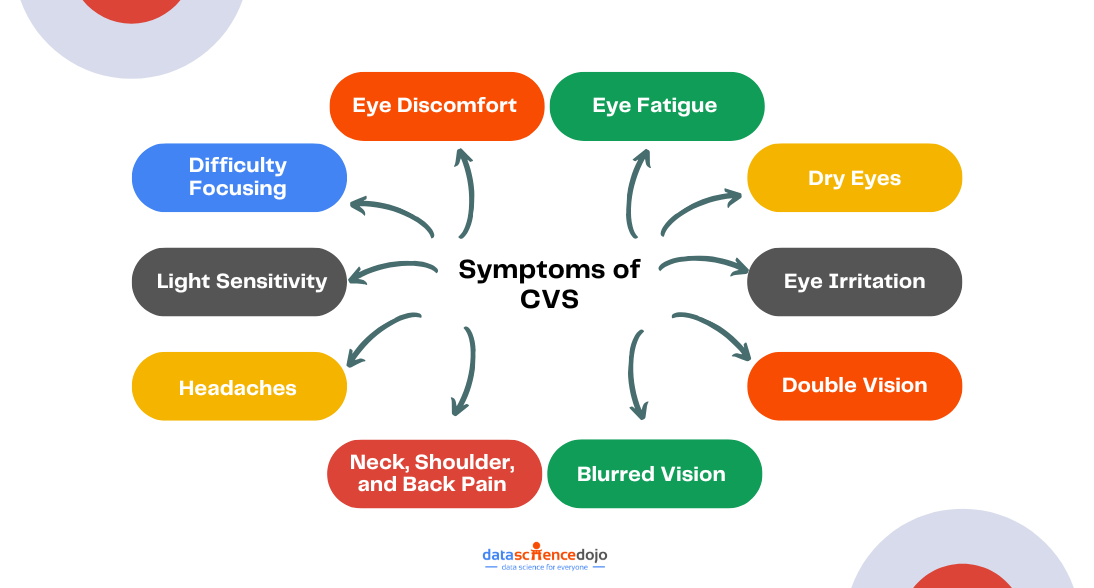In today’s digital age, our reliance on screens—whether for work, education, or leisure—has never been greater. With the rise of remote work, online learning, and constant smartphone use, many individuals are spending unprecedented amounts of time in front of digital devices.
This shift has brought convenience and connectivity but also a host of new health challenges. One such challenge is Computer Vision Syndrome (CVS), a condition that affects millions of people worldwide.
But what exactly is Computer Vision Syndrome?
In this blog, we will explore Computer Vision Syndrome (CVS) and understand its cause. We will also navigate through the steps to prevent and treat CVS.
What is Computer Vision Syndrome (CVS)?
Computer Vision Syndrome (CVS), also known as Digital Eye Strain, is a modern-day condition that arises from prolonged use of digital screens such as computers, tablets, smartphones, and e-readers.
It encompasses a range of eye and vision-related problems that result from extensive periods of staring at these devices. The symptoms can vary from dry eyes and blurred vision to headaches and neck pain, significantly impacting one’s comfort and productivity.
Why is it Important to Understand CVS?
With the advent of remote work, online education, and increased social activities on digital platforms, screen time has surged dramatically. The COVID-19 pandemic has further accelerated this trend, making digital device usage a central aspect of daily life for many.
Statistics reveal that Computer Vision Syndrome affects a substantial portion of the population. Before the pandemic, it was estimated that Computer Vision Syndrome (CVS) impacted at least 50% of adults. However, during the pandemic, this number escalated to 78%, reflecting the increased reliance on digital devices for work and social interactions.
Another interesting read: AI in healthcare
Children are not exempt from this trend; research indicates that about 50% to 60% of children experienced symptoms of CVS during the pandemic due to extended periods of online learning and screen time.
This widespread prevalence underscores the importance of recognizing and addressing CVS to maintain eye health and overall well-being in our increasingly digital world.
Symptoms of Computer Vision Syndrome
Computer vision syndrome encompasses a variety of symptoms that arise due to prolonged use of digital screens. The symptoms can vary in severity and often depend on the duration and frequency of screen use.
Here are the common symptoms associated with Computer Vision Syndrome ( CSV):

Eye-Related Symptoms
- Eye Discomfort: This is one of the most prevalent symptoms and can manifest as dryness, watering, itching, burning, or the sensation of something in the eye.
- Eye Fatigue: Prolonged screen time can cause significant strain and tiredness of the eye muscles.
- Dry Eyes: Reduced blinking rates while using screens can lead to dry, red, or irritated eyes.
- Eye Irritation: General irritation, including a gritty or foreign body sensation in the eyes, is commonly reported.
- Double Vision (Diplopia): Difficulty in maintaining clear single vision can occur, leading to double vision or diplopia.
- Blurred Vision: Users may experience intermittent blurring of vision, particularly when shifting focus between near and distant objects.
Systemic Symptoms
- Neck, Shoulder, and Back Pain: Poor posture and long hours at the computer can result in musculoskeletal discomfort, including pain in the neck, shoulders, and back.
- Headaches: Persistent headaches, especially those centered around the eyes, are common.
Visual Symptoms
- Light Sensitivity: An increased sensitivity to bright lights, also known as photophobia, can develop.
- Difficulty Focusing: Problems with maintaining focus on the screen or adjusting focus between different tasks can be a symptom.
If you are experiencing any or a combination of these symptoms, it is time to visit your eye doctor for a detailed checkup.
Causes and Risk Factors
Various factors contribute to the development of Computer Vision Syndrome (CVS), and certain risk factors can increase the likelihood of experiencing related symptoms.
Below are the detailed causes and risk factors:
Causes
- Extended Screen Time: Continuous use of digital devices like computers, tablets, and smartphones makes the eyes work harder, leading to CVS.
- Visual Demands: Digital screen viewing has unique characteristics such as less precise text definition, reduced contrast, and glare/reflections, which strain the eyes more than reading printed pages.
- Improper Viewing Distances and Angles: Viewing distances and angles for digital screens are often different from those used for other tasks, which can place additional demands on the visual system.
- Eye Focusing and Movement Requirements: The need for constant refocusing and eye movement when using digital screens can lead to discomfort and strain.
- Uncorrected Vision Problems: Even minor uncorrected vision issues like farsightedness or astigmatism can significantly impact comfort and performance, exacerbating CVS symptoms.
- Poor Lighting and Glare: Inadequate lighting and glare on digital screens can make viewing difficult and increase eye strain.
- Reduced Blinking: When using digital screens, the blink rate decreases, which can lead to dry eyes and irritation.
- Screen Quality: Factors like low resolution, poor image stability, and high brightness/contrast can contribute to visual discomfort.
Risk Factors
- Duration of Use: Individuals who spend two or more continuous hours at a computer or using a digital device each day are at a greater risk of developing CVS.
- Environmental Factors: Poor lighting, excessive glare, and improper workspace ergonomics can all contribute to CVS.
- Pre-existing Vision Problems: People with uncorrected or under-corrected vision issues, such as refractive errors or presbyopia, are more susceptible to CVS.
- Posture and Ergonomics: Incorrect seating posture and the improper arrangement of digital devices can lead to muscle spasms and pain in the neck, shoulders, and back, worsening CVS symptoms.
- Type of Device: The use of multiple digital devices simultaneously or switching between devices with different screen qualities can increase the risk of CVS.
- Contact Lens Use: Regular use of contact lenses, especially for more than six hours a day, can increase the risk of CVS due to higher chances of dry eyes and discomfort.
- Age and Gender: Higher age and female gender, especially postmenopausal women, are additional risk factors due to susceptibility to dry eye syndrome.
- Environmental Conditions: Factors like air conditioning, low humidity, and airborne particles can aggravate CVS symptoms.
Understanding the causes and risk factors of CVS is crucial for implementing effective preventive measures and mitigating its symptoms. However, before digging deeper into its preventive measures, let’s understand how computer vision syndrome is diagnosed.
What Steps Doctors Take to Diagnose CVS?
CVS diagnosis involves a comprehensive eye examination and detailed patient history to understand the symptoms and their severity. Let’s explore the basic steps typically taken to diagnose CVS:
Thorough Eye Examination
An eye care specialist will conduct a comprehensive eye exam to determine the overall health of your eyes and identify any vision problems.
Patient History
The patient will be asked about their symptoms, how often they occur, and their severity. This helps the provider understand the specific issues related to computer use. The patient may also need to provide information about:
-
- The amount of time spent using digital devices.
- Work environment and posture.
- Any existing medical conditions.
- Medications being taken.
- Family history of eye diseases or vision problems.
Also learn about data science in healthcare
Visual Acuity Measurements
These tests assess how well you can see at various distances. It helps determine the extent to which vision may be affected by CVS.
Refraction Test
This test determines the appropriate lens power needed to correct any refractive errors, such as nearsightedness, farsightedness, or astigmatism, which can contribute to CVS if uncorrected.
Testing Eye Focus and Coordination
This involves checking how well the eyes focus, move, and work together to form a clear image. It includes examining for problems like convergence insufficiency and accommodative issues that can exacerbate CVS symptoms.
Blink Rate and Completeness
Since reduced or incomplete blinking is common during extensive screen use, evaluating the blink rate can help diagnose dry eye symptoms associated with Computer Vision Syndrome.
Questionnaires
Various questionnaires can be used to quantify the frequency and intensity of symptoms. These may include questions about burning, itching, feeling of a foreign body, tearing, and other symptoms.
A combination of these diagnostic methods helps eye care specialists accurately diagnose CVS and recommend appropriate treatments to manage and alleviate symptoms.
Treatment and Management
While we understand the symptoms and impact of computer vision syndrome, we must also discuss ways to manage Computer Vision Syndrome. Below are some common strategies to address the underlying causes and symptoms.
1. Managing Dry Eyes
Artificial Tears: Use over-the-counter eye drops to add moisture to the eyes.
Prescription Eye Drops: In cases of severe dry eye, prescription eye drops may be recommended.
Blink More Often: Make a conscious effort to blink more frequently to help natural tears soothe the eyes.
Environmental Adjustments: Increase the moisture level in the room using a humidifier and avoid direct air from vents or fans blowing into your face.
2. Correcting Vision
Eyeglasses or Contact Lenses: Correct any refractive errors with appropriate eyewear. Computer glasses, specifically designed for intermediate-distance vision, can be particularly effective.
Anti-Glare Lenses: Use glasses with anti-glare coatings to reduce screen glare.
Specialized Lenses: In some cases, lenses designed to reduce blue light exposure may be recommended, although their benefits are not universally proven.
3. Changing Routine and Environment
Reduce Screen Time: Limit the use of digital devices to fewer than four hours per day when possible.
Take Regular Breaks: Follow the 20-20-20 rule: every 20 minutes, look at something at least 20 feet away for about 20 seconds. Additionally, take a 15-minute break after every two hours of continuous screen use.
Setup an Ergonomic Workstation: Ensure your workstation is ergonomically optimized. You can do this through the following steps:
- Position your computer screen 20 to 28 inches away from your eyes and slightly below eye level.
- Adjust your chair height so your feet rest flat on the floor and your knees are level or slightly higher than your hips.
- Use a chair with good back support and keep your shoulders relaxed.
Adjust Screen Settings: Modify the brightness and contrast of your screen to match the ambient lighting in the room. A screen contrast of around 60% to 70% is usually comfortable.
Limit Glare and Reflections: Use curtains or blinds on windows, and consider an anti-glare screen filter for your monitor.
By combining these treatment and management strategies, you can significantly reduce the symptoms of Computer Vision Syndrome and enhance their comfort and productivity during digital device use. Moreover, you should also opt for regular eye check-ups to ensure your vision is properly corrected and to detect any early signs of Computer Vision Syndrome.
Embracing Eye Health in the Digital Age
In today’s digital era of remote work and digital media, computer vision syndrome has become a significant health issue. Ignoring symptoms like eye strain, blurred vision, and headaches can reduce productivity and quality of life.
Hence, prioritizing eye health in our digital world is crucial, ensuring long-term well-being. By adopting these measures, you can enjoy technology’s benefits without compromising eye health, navigating the digital landscape with ease.





